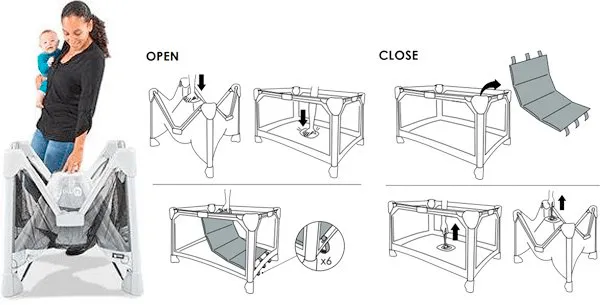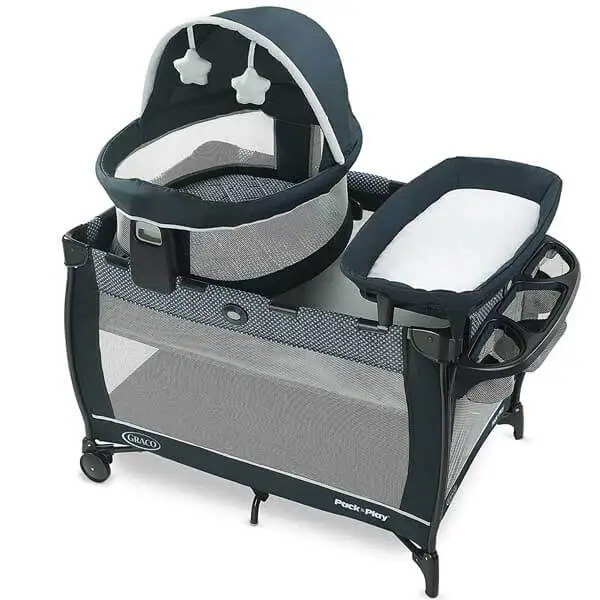
Pack ‘N Play Safety Standards and Safe Sleep Recommendations
Pack ‘N Plays are a staple for modern parents, providing a versatile space for babies to sleep and play.
Did you know that over 60% of parents in the U.S. use a Pack ‘N Play as a secondary sleeping arrangement for their baby?
If you’re wondering whether a Pack ‘N Play is safe for your little one, you’ve come to the right place. This article will guide you through everything you need to know, including safety standards, proper usage, second-hand options, and tips for choosing the safest accessories.
Is a Pack ‘N Play Safe for My Baby?
Yes, Pack ‘N Plays (also called Playards) are generally a safe sleeping space for your baby—but only if used properly!
New Pack ‘N Plays must meet strict federal safety standards set by the Consumer Product Safety Commission (CPSC) and undergo extensive testing before they can be sold, so you can trust they’re certified safe for infants. However, true safety depends on you! Always follow the manufacturer’s instructions and adhere to safe sleep guidelines to ensure your baby stays safe while using a Pack ‘N Play.
Key Steps to Ensure Pack ‘N Play Safety:
- Purchase a Pack ‘N Play manufactured after February 28, 2013, when updated safety standards went into effect.
- Check for recalls on older or second-hand models.
- Inspect the unit for damaged or loose parts before each use.
- Ensure the Pack ‘N Play is fully assembled and stable before placing your baby inside.
- Use only the included mattress pad and a fitted sheet specifically designed for your model.
- Avoid adding third-party mattresses, blankets, or toys.
- Follow the height and weight limits specified by the manufacturer.
Looking for the safest Pack ‘N Play models? Check out our article on The Best Pack ‘N Plays in 2025 for expert recommendations.
Safety Standards for Pack ‘N Plays
The 2013 federal safety standards require Pack ‘N Plays to undergo rigorous testing to ensure stability, durability, and safety. Here’s a detailed summary of the key safety features and tests:
Considering a second-hand Pack ‘N Play? Ensure it meets these criteria and hasn’t been recalled. Check out our detailed guide: How to Evaluate a Used Pack ‘N Play for Safety.
How to Use a Pack ‘N Play Safely
Proper use is key to ensuring your baby’s safety. Follow these steps to set up and use your Pack ‘N Play:
1. Assembly Tips:
- Always follow the owner’s manual for setup instructions.
- Ensure the floor is fully locked in place, and the top rails are secure before adding the mattress pad.

At first, you may find the Pack ‘N Play assembly a bit confusing, but most units are simple to set up and put away. Once you get used to it, you’ll be done in a minute.
2. Choosing the Right Spot:
- Place the Pack ‘N Play away from windows, cords, strings, and heavy objects that could fall.
- Avoid setting it up near cold exterior walls or direct sunlight.
3. Safe Sleep Practices:
- Use only the included Pack ‘N Play mattress pad. Find out why you can not put a thicker mattress in a Pack ‘N Play here.
- Use only a fitted sheet designed for your model. If you need more info about Pack ‘N Play sheets, click here.
- Remove any loose bedding, toys, or accessories when your baby is sleeping.
- Lay your baby on their back on a firm, flat mattress.
- For the first six months, place your Pack ‘N Play next to your bed. The AAP (American Academy of Pediatrics) recommends room-sharing rather than bed-sharing.
4. Weight and Height Limits:
- Most models are safe up to 30 lbs or 35 inches tall.
- Stop using the Pack ‘N Play if your child begins climbing out.
How to Safely Use Pack ‘N Play Accessories
Many Pack ‘N Plays come with useful accessories like bassinets, changing tables, and storage units. While these add-ons provide convenience, it’s essential to use them correctly to ensure your baby’s safety.
Common Pack ‘N Play Accessories and Safety Precautions:
- Full-Size Bassinet Insert: Clips onto the sides of the Pack ‘N Play and hangs inside the unit to elevate the sleeping space for infants. → Only use flat, firm bassinets with mesh sides designed for your specific model.
- Raised Bassinet: A smaller, detachable infant bassinet that clips on the Pack ‘N Play and stands above the unit. → Some models double as free-standing bassinets. Always secure the bassinet to the Pack ‘N Play properly, and never use it for overnight sleep.
- Changing Table: A removable or flip-away diaper changer that attaches to the top of the Pack ‘N Play. → Ensure it is securely attached during use, and always remove it when it’s no longer needed to avoid accidents.
- Nappers and Rockers: Removable newborn units that clip to the Pack ‘N Play’s top, sometimes doubling as stand-alone units. → These should never be used for unsupervised or overnight sleep.
- Storage Units: Built-in shelves, diaper organizers, or attachable storage units for convenience. → Keep these well-secured to prevent tipping or falling.
A great Pack ‘N Play with numerous Accessories: Graco Pack n Play Dome LX Playard with Baby Bassinet

Second-Hand Pack ‘N Plays: Are They Safe?
Buying a second-hand Pack ‘N Play can save money, but it’s essential to ensure it meets modern safety standards to protect your baby. Older models, especially those made before 2013, may not comply with updated federal safety regulations, posing risks.
Quick Checklist for Evaluating a Used Pack ‘N Play:
- Check the manufacture date (post-2013 models are safer).
- Verify that all parts, including the mattress and rails, are intact.
- Look for signs of wear and tear, such as frayed mesh or loose joints.
- Confirm it hasn’t been recalled by searching the model number online.
Want a more detailed guide? Read our article on How to Ensure Your Used Pack ‘N Play is Safe.
FAQs About Pack ‘N Play Safety
1. Can a baby sleep in a Pack ‘N Play every night? Yes, as long as you follow safe sleep guidelines, a Pack ‘N Play is a safe and portable sleeping solution for your baby.
2. Are thicker mattresses safe for Pack ‘N Plays? No. Only use the included mattress pad, as thicker ones can create suffocation risks.
3. What is the weight limit for Pack ‘N Plays? Most models support up to 30 lbs. Always check your unit’s specific guidelines.
Final Thoughts:
Pack ‘N Plays are safe and flexible options for parents. To keep your child safe, always follow the safety guidelines and use the unit correctly. Whether you buy a new one, a second-hand one, or accessories, make safety your top priority!
Explore our curated list of the Best Pack ‘N Plays in 2025 for more insights and recommendations.
